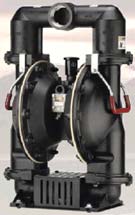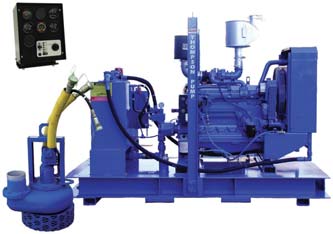
Grindex’s Mega.
Pump Update: Pushing Performance Parameters
New products offer solutions for almost any pumping problem, from high head conditions
to real-time data collection and alarm monitoring for large, mine-wide pumping systems

Over the past year or so, leading pump manufacturers have introduced a number of new models offering higher performance for challenging pumping applications.
Grindex (www.grindexpumps.com), for example, added the Mega model to its range of large dewatering pumps. According to the company, the Mega is ideal for deep sites such as open-pit and underground mines, quarries, tunnel projects and other industrial applications where very high head pumping is required. Equipped with optional zinc anodes, it is also well-suited for corrosive applications. The 140-hp, two-pole pump comes in two versions: the N, a 6-in. unit with a capacity of almost 2,500 gpm and heads up to 330 ft; and the 4-in. H, which provides capacity of almost 900 gpm and heads up to 750 ft.

As with all Pioneer Prime pumps, the PP86C21 comes with an SAE 1 housing allowing for direct drive from the engine, eliminating the need for gearboxes or intermediate shafts.
The new pumps will include standard features previously found in the proven C17 high pressure pump range such as guaranteed run-dry capability.
Godwin Pumps (www.godwinpumps. com) continues to offer its HL160M unit for mine dewatering duty, providing heads to 600 ft, maximum flow up to 2,000 gpm, and passing solids up to 1-3/8 in. in diameter. This model has a working pressure of 285 psi and 90 psi of suction pressure. As is the case with all Godwin Dri- Prime pumps, the HL160M automatically primes from dry to 28 ft of suction lift. The pump can run dry during intermittent flow without damage, due to its high-pressure oil-bath, double mechanical seal fitted with solid silicon carbide faces.
Monoflo (www.monoflopumps.com) has developed mine dewatering stations that can operate in fixed or mobile applications. These systems feature a specially designed Monoflo progressing cavity pump equipped with long-wearing components and special coatings that the company says were developed specifically for the mining industry. Notable features of the pump include a Halar-coated PowerDrive transmission warranted for five years, standard 316 stainless steel hard chrome-plated rotor, abrasion- resistant synthetic rubber stator, purpose- built bearing housing for mining environments, and a unique gland arrangement that can offer up to a threefold reduction of drive-shaft wear. A single greasing point for the pump and motor, and walkways and ladders for washdown and inspection enhance unit maintenance efficiency.

Gorman-Rupp (www.gormanrupp.com) claims its line of engine-driven, self-priming centrifugal pumps offers the broadest range of its type in the industry, encompassing its Super T and Ultra V Series portable units in sizes ranging from 1.5 in. to 10 in., heads to 175 ft, flows to 3,500 gpm, solids handling capacity up to 3 in. and either Deutz or Deere diesel power. The company also offers its 10 Series self-priming models for medium-head dewatering applications, and severe-duty 80 Series pumps for similar applications with continuous workloads.
Griswold Pump (www.griswoldpump. com) says its 4-, 6- and 8-in. submersible turbine pumps provide high flow rates; for example, its 6-in. units are rated up to 550 gpm, while the 8-in. pumps feature rates to 1,000 gpm. Other key components designed into the product line include discharge, intermediate bowls and motor brackets fabricated from heavy-duty Class 30 cast iron for maximum efficiency and abrasion resistance, with long-life bronze bearings used in every stage; impellers made of balanced, lead-free silicon bronze, designed for maximum efficiency with a wide range of hydraulic coverage and corrosion-resistance; and availability in custom sizes, including special-order 10-, 12- and 14-in. units.
Starting, Stopping...and Staying in Service
Thompson Pump (www.thompsonpump.
com) recently announced that it has developed
an automatic start/stop system for
hydraulic submersible pumps. Thompson’s
system energizes and de-energizes the
hydraulic circuit while automatically
adjusting the speed of the hydraulic power
unit. Typical hydraulic power units, says
the company, require manual start and
stop, manual needle valve adjustment and
manual speed adjustment.
Thompson says that not only does this innovation make pump operation easier and less time consuming—reducing labor costs in the process—it also allows for significant fuel savings. Engine wear is also reduced because the automatic throttle control allows the engine to warm-up and cool-down properly.

ITT Water & Wastewater (www.ittwww. com) recently introduced Active Seal, a new patented seal technology developed to eliminate the risk of potentially damaging leakage into the dry parts of submersible pumps. Active Seals are gradually being introduced on several Flygt pumps and mixers.
According to the company, all mechanical face seals leak to a certain extent—a minor amount of liquid penetration between the seal faces is a part of a seal design and is necessary to keep the seal faces lubricated to prevent from seizing. But, even minimal leakage in mechanical face seals may cause problems over time, especially for pumps and mixers in continuous operations. Along with a major leakage, such accumulated leakage may result in higher maintenance requirements or machine failure.
The Active Seal is a zero leakage seal for the inner position, allowing no liquid to penetrate from the buffer fluid compartment to the stator housing of the pump or mixer. The Active Seal acts a micro-pump, pumping media from the drive-unit side to the buffer fluid side of the inner seal. The pumping action is achieved by laser cut grooves in the rotating seal face. This unique design ensures that the net inflow, the actual leakage, is always nil.
Optimization and Control
In addition to the pump reference materials
and “pump schools” offered by a number of
major manufacturers, there are generalized
guidebooks available that cover various
aspects of pump system configuration and
usage. One of the most recent of these is
the Hydraulic Institute’s (http://pumps.org)
Optimizing Pumping Systems: A Guide to
Improved Efficiency, Reliability, and
Profitability, a 250-page compendium that
explains how optimizing both existing and
new pumping systems, and purchasing
based on lifecycle cost, can lead to
increased profitability through a reduction
in unnecessary, expensive energy consumption
and maintenance costs.
For large mines with extensive dewatering requirements and activity, Colorado, USAbased In-Situ Inc. (www.in-situ.com) offers a line of instrumentation that can be used from the start of site assessment to real-time data monitoring of a large number of dewatering wells. For example, its Level Troll 700 instrument allows characterization of a site during initial feasibility studies by measuring and logging water level, pressure, and temperature. The device offers advanced logging modes such as true logarithmic and step linear sampling, used during large scale pumping tests to accurately monitor drawdown and determine hydraulic conductivity. The Level Troll 500 instrument monitors daily mine operations by measuring and logging water level, pressure, and temperature. The company offers additional water quality monitors as well, along with its Link telemetry system that provides critical data to mine engineers and operators in real time, negating the need for site visits to remote locations. The system also can be set to alarm personnel to changing well or system conditions via email, SMS text or phone.